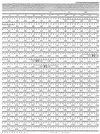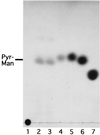Polysaccharide lyase: molecular cloning, sequencing, and overexpression of the xanthan lyase gene of Bacillus sp. strain GL1
- PMID: 11157235
- PMCID: PMC92639
- DOI: 10.1128/AEM.67.2.713-720.2001
Polysaccharide lyase: molecular cloning, sequencing, and overexpression of the xanthan lyase gene of Bacillus sp. strain GL1
Abstract
When grown on xanthan as a carbon source, the bacterium Bacillus sp. strain GL1 produces extracellular xanthan lyase (75 kDa), catalyzing the first step of xanthan depolymerization (H. Nankai, W. Hashimoto, H. Miki, S. Kawai, and K. Murata, Appl. Environ. Microbiol. 65:2520-2526, 1999). A gene for the lyase was cloned, and its nucleotide sequence was determined. The gene contained an open reading frame consisting of 2,793 bp coding for a polypeptide with a molecular weight of 99,308. The polypeptide had a signal peptide (2 kDa) consisting of 25 amino acid residues preceding the N-terminal amino acid sequence of the enzyme and exhibited significant homology with hyaluronidase of Streptomyces griseus (identity score, 37.7%). Escherichia coli transformed with the gene without the signal peptide sequence showed a xanthan lyase activity and produced intracellularly a large amount of the enzyme (400 mg/liter of culture) with a molecular mass of 97 kDa. During storage at 4 degrees C, the purified enzyme (97 kDa) from E. coli was converted to a low-molecular-mass (75-kDa) enzyme with properties closely similar to those of the enzyme (75 kDa) from Bacillus sp. strain GL1, specifically in optimum pH and temperature for activity, substrate specificity, and mode of action. Logarithmically growing cells of Bacillus sp. strain GL1 on the medium with xanthan were also found to secrete not only xanthan lyase (75 kDa) but also a 97-kDa protein with the same N-terminal amino acid sequence as that of xanthan lyase (75 kDa). These results suggest that, in Bacillus sp. strain GL1, xanthan lyase is first synthesized as a preproform (99 kDa), secreted as a precursor (97 kDa) by a signal peptide-dependent mechanism, and then processed into a mature form (75 kDa) through excision of a C-terminal protein fragment with a molecular mass of 22 kDa.
Figures





Similar articles
-
Xanthan: enzymatic degradation and novel perspectives of applications.Appl Microbiol Biotechnol. 2024 Feb 21;108(1):227. doi: 10.1007/s00253-024-13016-6. Appl Microbiol Biotechnol. 2024. PMID: 38381223 Free PMC article. Review.
-
Polysaccharide lyase: molecular cloning of gellan lyase gene and formation of the lyase from a huge precursor protein in Bacillus sp. GL1.Arch Biochem Biophys. 1998 Jun 1;354(1):31-9. doi: 10.1006/abbi.1998.0674. Arch Biochem Biophys. 1998. PMID: 9633595
-
Xanthan lyase of Bacillus sp. strain GL1 liberates pyruvylated mannose from xanthan side chains.Appl Environ Microbiol. 1998 Oct;64(10):3765-8. doi: 10.1128/AEM.64.10.3765-3768.1998. Appl Environ Microbiol. 1998. PMID: 9758797 Free PMC article.
-
Posttranslational processing of polysaccharide lyase: maturation route for gellan lyase in Bacillus sp. GL1.Arch Biochem Biophys. 2004 Feb 15;422(2):211-20. doi: 10.1016/j.abb.2003.12.015. Arch Biochem Biophys. 2004. PMID: 14759609
-
Bacillus brevis, a host bacterium for efficient extracellular production of useful proteins.Biotechnol Genet Eng Rev. 1989;7:113-46. doi: 10.1080/02648725.1989.10647857. Biotechnol Genet Eng Rev. 1989. PMID: 2696470 Review. No abstract available.
Cited by
-
Cloning of the Trichoderma reesei cDNA encoding a glucuronan lyase belonging to a novel polysaccharide lyase family.Appl Environ Microbiol. 2009 Jan;75(1):101-7. doi: 10.1128/AEM.01749-08. Epub 2008 Oct 31. Appl Environ Microbiol. 2009. PMID: 18978091 Free PMC article.
-
A novel eliminase from a marine bacterium that degrades hyaluronan and chondroitin sulfate.J Biol Chem. 2014 Oct 3;289(40):27886-98. doi: 10.1074/jbc.M114.590752. Epub 2014 Aug 13. J Biol Chem. 2014. PMID: 25122756 Free PMC article.
-
Production and purification of a novel xanthan lyase from a xanthan-degrading Microbacterium sp. strain XT11.ScientificWorldJournal. 2014;2014:368434. doi: 10.1155/2014/368434. Epub 2014 Jun 26. ScientificWorldJournal. 2014. PMID: 25054177 Free PMC article.
-
Novel Endotype Xanthanase from Xanthan-Degrading Microbacterium sp. Strain XT11.Appl Environ Microbiol. 2019 Jan 9;85(2):e01800-18. doi: 10.1128/AEM.01800-18. Print 2019 Jan 15. Appl Environ Microbiol. 2019. PMID: 30413476 Free PMC article.
-
Xanthan: enzymatic degradation and novel perspectives of applications.Appl Microbiol Biotechnol. 2024 Feb 21;108(1):227. doi: 10.1007/s00253-024-13016-6. Appl Microbiol Biotechnol. 2024. PMID: 38381223 Free PMC article. Review.
References
-
- Ahlgren J A. Purification and properties of a xanthan depolymerase from a heat-stable salt-tolerant bacterial consortium. J Ind Microbiol. 1993;12:87–92.
-
- Ausubel F M, Brent R, Kingston R E, Moore D D, Seidman J G, Smith J A, Struhl K. Current protocols in molecular biology. New York, N.Y: Greene Publishing Associates and Wiley-Interscience; 1987.
-
- Bellach M R, Capage M A, Doherty D H, Hassler R A, Henderson N M, Vanderslice R W, Marellia J D, Ward M B. Genetically engineered polymers: manipulation of xanthan biosynthesis. In: Yalpani M, editor. Industrial polysaccharides: genetic engineering, structure/property relations and applications. Amsterdam, The Netherlands: Elsevier; 1987. pp. 35–80.
MeSH terms
Substances
Associated data
- Actions
LinkOut - more resources
Full Text Sources

